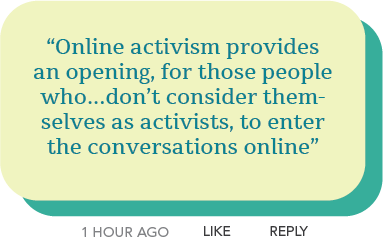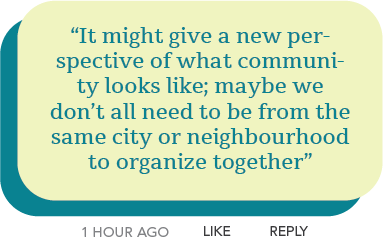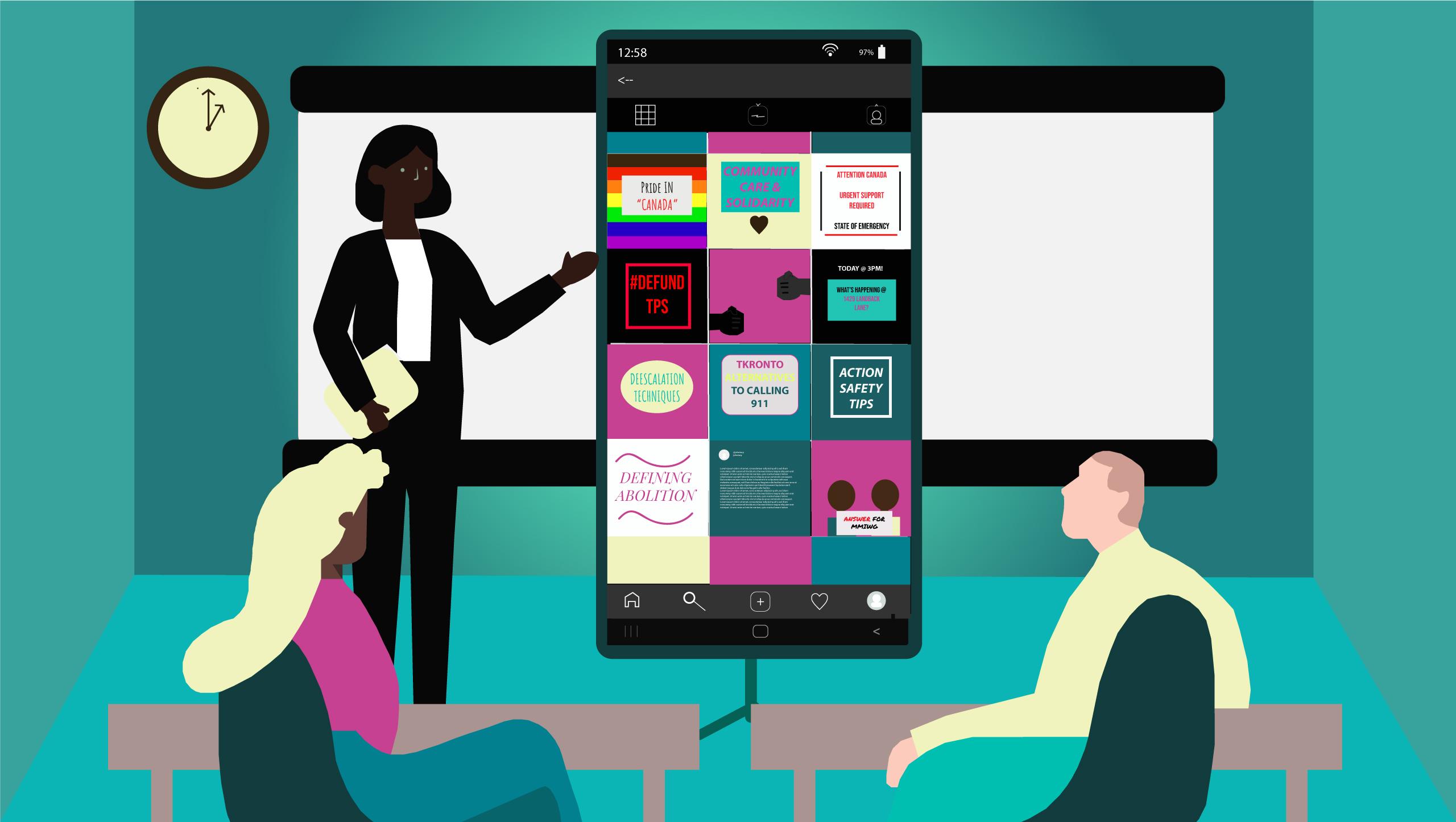The rise in online advocacy has helped student activists to find strength in numbers
Words by Kayla Zhu
Illustrations by Jimmy Kwan
On a sunny June afternoon, Emma Zuck and a group of her friends headed to Kiwanis Memorial Park in her hometown of Saskatoon. They had decided to march at a peaceful protest in solidarity with the global Black Lives Matter (BLM) movement. Zuck was excited to attend her first protest, but felt nervous about how things might unfold if tensions were to escalate.
She packed a bag with all the “protesting essentials” she had seen circulating online, including snacks, Sharpies, water, Band-Aids and eye protection. She also told her friends to write one phone number on their arms in case any of them were to get arrested. At the height of the protests across the U.S. in June, she had seen protestors get arrested and attacked by police officers on social media.
On the way to the park, Zuck reviewed the citizens’ rights that she was entitled to on the Canadian government’s website, just in case they were stopped by a police officer at any point. She mentally prepared for the worst case scenario and thought about how she might intervene if people around her were to get in any trouble.
However, the protest turned out to be anything but hostile, according to Zuck. She described the march as “filled with power,” with people feeding off each other’s energy and marching all day under the glaring hot sun. Organizers from BLM Saskatoon handed out hand sanitizer, masks and water to attendees and distributed maps that plotted out the march route and speaker stops ahead of the event.
Seeing the hundreds of attendees—with a noticeably large number of BIPOC people in her predominantly white hometown showing up—gave Zuck goosebumps. In Saskatoon, which she describes as a mostly “conservative, homogeneous small city,” activist events like this were few and far between. She had never seen anything on this scale in the city before, all “carved” out from strong, online organizing.
“There was a moment where we all kneeled, and it felt like nothing I’d ever experienced,” says Zuck. “All sorts of emotions, the lasting one being hopeful.”
Zuck, now a second-year film student at Ryerson, was involved in different social justice groups in high school and has been outspoken about social issues, from Indigenous issues to queer rights, since she was 14.
In high school, she mostly posted photos from social justice events or artwork from community artists on her Instagram and ran a YouTube channel where she talked about issues like rape culture, body image and the history of Asian marginalization in Canada.
Back then, she felt like it was controversial to post social justice content on social media because few of her peers shared the same opinions as her on those issues. Coming back to her hometown this summer, with the BLM movement finally coming to the forefront in mainstream culture, was a “complete switch” for her.
Zuck says she felt like the ways that people used social media changed as a result of the overwhelming support and discourse happening online around racial injustices, and it’s now more controversial to be uninformed and silent.
Seeing her old high school classmates broadcast their experience at the Saskatoon rally on social media gives Zuck mixed feelings. While she acknowledges that it’s not her place to judge peoples’ motivations, she was a bit skeptical of people who were covertly or openly racist in high school now posting and protesting without acknowledging their past.

She says she wonders if people are genuinely “having a change of heart” or whether it was because being supportive of BLM is now part of the status quo.
“There’s this precedent now online that these are things we care about,” says Zuck.
Zuck currently uses her Instagram account to speak on issues she cares about, including police abolition and Black trans rights. There she also shares readings, tweets, posts and articles from BIPOC and LGBTQIA+ activists and academics.
“Even though it’s very limited, it’s still a platform nonetheless to point people in the direction of those most knowledgeable and most deserving,” says Zuck.
In the wake of a global pandemic and racial reckoning magnified by the murder of George Floyd, virtual activism has become a powerful force in turning online words to real-world action.
From matching donations to the Minnesota Freedom Fund, which has since raised more than $30 million, to TikTok users and K-pop fans booking empty seats for President Donald Trump’s Tulsa, Okla. rally, social media platforms have been used to educate and galvanize mass audiences online.
Jacqui Gingras, a Ryerson associate sociology professor says that many people who wouldn’t have considered themselves activists prior to this summer may have been inspired to contribute after watching an uprising unfold online.
“Online activism provides an opening, a doorway for those people who perhaps don’t know what to do and don’t consider themselves as activists, to enter the conversations online where it may be safer and more private,” says Gingras.
A 2020 article from Current Opinion in Psychology found that social media’s ability to document individual experience, build community and develop “shared social realities” are the most prominent ways it facilitates online activism.
Online platforms like social media and video conferencing software have made engaging with activism more accessible for those who can’t attend physical events or access educational resources. For activists who often don’t have access to traditional platforms like mainstream media or academia, social media has given them the power to reach wider audiences.
“Most educational spaces are white and often rich, so the idea that Black, Indigenous and people of colour can carve this digital space that is facilitated by them and for them is very powerful,” said Zuck.
Gingras says that while the pandemic has shut down events and restrained in-person activism, social media allowed people to draw international attention to the protests that were happening on the streets. She said that usually, “in the capitalist system, there are many distractions that keep us too busy to participate” in activism. But during a time when everyone was at home, more people were paying close attention to what was happening in Minneapolis, across the United States and now in the Maritimes with racist violence against Mi’kmaq lobster fisheries.
The efficacy of online organizing has led to real, tangible results during a time where governments and institutions are being called out and exposed for systemic injustices. With our society shifting towards an increasingly digital future, the ways social media is wielded by activists can have a significant impact on how much attention and support an issue receives and as a result, how responsive institutions are to demands for change.
Ryerson students have seen success with their own online campaigns, from implementing a new Black reporting class at the journalism school to cancelling the controversial special constable program.
A few years prior, online activism largely consisted of Facebook profile picture slacktivism and Instagram posts like Zuck’s. But, the online tools of organizers today have made it easier to share information, raise awareness and contact those in power.
Gingras says that online activist tools have become more sophisticated recently, citing engagement platforms as well as email and phone zaps as examples. Zaps are tools that allow people to fill out their contact information into a pre-written email or phone script that can be used to easily contact relevant local officials.
Social media has also allowed those in precarious, isolated situations, such as sex workers or those facing homelessness, to connect to a wider community for support, according to Gingras.
Michael DeForge, a freelance illustrator and comic book artist says that online activity like viral Twitter threads and Instagram explainers have become a popular form of political education that has introduced people to ideas such as abolition.
DeForge has created graphics and illustrations for the Encampment Support Network, a group that organizes clothing and supplies drives for people living in encampments in Toronto and labour unions. He says that social media is a powerful space to spark discussion and raise consciousness about both local and global issues.
“I think what we’re seeing is a lot of people being politicized right now, and it makes sense that some of that would translate into online activity,” says DeForge.

his June, Ryerson’s journalism school sent out an email acknowledging widespread racism faced by Black, Indigenous and racialized journalists and asked their BlPOC students how they could do better.
The email, titled “Watching the horrors, hearing the anger, going forward at the RSJ” said faculty and staff had met to discuss their responsibility to BlPOC students and communities.
“If you want to talk to the School of Journalism’s leadership team about how you think we should respond to racism generally or anti-Black racism specifically, we’d love to hear from you,” the email read.
After receiving the email, a group of four recent journalism graduates, Tiffany Mongu, Rosemary Akpan, Sara Jabakhanji and Breanna Xavier-Carter, began sharing ideas on how to improve the program. They discussed their own negative experiences as women in the program, from microaggressions to being the only Black person in their classroom, and how that had created an unwelcoming learning environment for them.
Mongu also felt like the program failed to teach non-Black students the importance of covering Black issues or how to report on Black communities responsibly. Some of the group members were initially a bit nervous about getting in trouble, but Mongu and Jabakhanji reassured them that their initiative wouldn’t “cause any repercussion besides change.” They decided to compile all of their ideas into one main goal: the creation of a Black reporting class to teach students how to efficiently report on the Black community and unlearn previous harmful media treatment of those groups.
The group made a Change.org petition in July calling for their school to implement a Black-Canadian reporting course and shared the link widely on their social media accounts, predominantly on Twitter. The petition garnered more than 3,500 signatures.
PETITION FOLLOW UP: As a result of my wonderful friends & I’s petition, Ryerson School of Journalism will now offer “Reporting on Race: The Black Community in the Media” — in the Fall to 3rd/4th year undergraduate students + MJ2 graduate students. https://t.co/mJYLn3voyD
— Tiffany Mongu (@mongumnews) June 15, 2020
A few days after the petition was created, the school announced a new course, Reporting on Race: The Black Community in the Media. According to the course description, the course will “cover the history of Black Canadians and how problematic narratives have perpetuated racial biases and systemic injustice.”
The course is taught by a Ryerson journalism alumni and Toronto-based journalist, Eternity Martis. This March, Martis released her bestselling book They Said This Would Be Fun: Race, Campus Life, and Growing Up on her experience as a Black woman at Western University, which she describes as predominantly white.
Mongu says that the petition wouldn’t have been successful if not for tools such as Change.org and Twitter.
Despite often being ignored by the institutions they address, petitions are a powerful way to raise consciousness and recruit individuals into a cause, according to a 2016 Cambridge University study. Signatures on a petition hold value in the petition’s expressive purposes by providing evidence of the number of people who support the cause.
According to SimilarWeb, Change.org’s traffic peaked this year in June at 147 million total visits and has averaged around 97.5 million visits in the past four months. In 2019, the company grew to over 300 million users and saw 673 million signatures from all over the world, according to their 2019 impact report.
This May, the “Justice for George Floyd” petition became the most-signed petition of all time on Change.org. The petition, which has since amassed over 19.5 million signatures, called for the four Minneapolis police officers involved in Floyd’s killing to be fired and criminally charged.
A widely-circulated GoFundMe organized by a family member of Breonna Taylor has raised over $6 million dollars from over 206,000 donors to establish a foundation in Taylor’s honour. The petition also lists six demands, including firing and revoking the pensions of the officers that killed Taylor.
“Especially in the midst of a pandemic, everybody was on their phones and on their computers all the time,” says Mongu. “It’s just an easy place to turn to when you’re trying to look for information or to see what’s new.”
Although the campaign did receive disparaging comments, such as people calling BLM an “oppressive movement” and asking why there wasn’t a white reporting class, Mongu asserts that the course is crucial.
“The future of journalism depends on the hands of those that are coming to school and learning these things,” says Mongu. “What good will it serve if these students enter these schools, and they don’t know how to properly report on marginalized communities, on the Black community?”

eremy Bland, a member of the Ryerson chapter of Canadian Students for Sensible Drug Policy (CSSDP) says that with quarantine forcing people to stay at home, many people began to “open their eyes and see what’s going on in the world.”
The CSSDP launched their “Policing in Post-Secondary” campaign this spring with the goal of cancelling Ryerson’s proposed special constable program. This added onto the continual activism and work initiated by the Black Liberation Collective’s (BLC) “No Cops On Campus” campaign that was launched in 2018.
Bland says that the campaign really sped up after the Toronto Police Services board voted in favour of the Ryerson special constable motion during its May 21 meeting. Bland and two other people gave deputations at the meeting to voice their opposition to the motion.
After the motion passed, the group felt pressure to get the campaign moving. They put together a webinar, prepared an email zap and started student and faculty petitions to share during the webinar.
On June 4, Ryerson’s Twitter account announced that Ryerson would “not be proceeding with special constables.”
Bland says Ryerson hasn’t clearly cancelled the program, but has chosen to put it on hold for this fall and winter semester. The wording of the announcement states that the program proposal has been withdrawn, which he says means that the university could technically move forward with it in the future.
Despite the unclear fate of the program, he says that the campaign was still a big success and that it was exciting to see the email zap he put together “blow up” and be signed over 1,200 times. He noticed more students taking action during this campaign and says it was amazing to see so many people willing to stand up for Black students, faculty and community members.
Bland said that organizing online through Zoom calls has made it much more accessible for people to attend events. Since events don’t require commuting to a physical location, the group has seen more new members attend or watch their meetings and webinars. More than 2,000 people engaged with their most recent webinar on Facebook, whereas their in-person events typically saw between 50 to 150 participants. In general, they’re also able to do more organizing for less money in terms of cutting the costs of event space and catering.
The CSSDP ran their first digital Naloxone training on Sept. 3 through a recorded Zoom meeting, which Bland says was met with a good response from their community members. The group also hosted a webinar on Sept. 29 that updated members on Ryerson’s special constable proposal and held a panel discussion on the implications of universities investing in “the militarization of campuses.”
Join us at 7pm tonight as we go LIVE with our webinar: No Cops on Ryerson Campus! https://t.co/1TifFum782 pic.twitter.com/gySfC8iHj3
— CSSDP Ryerson (@CSSDPRyerson) May 14, 2020
Bland says he’s working on getting live captioning for the digital events, which he says is much more feasible to do online than in-person.
However, Bland says that online organizing presents different accessibility challenges for people without access to stable internet connection, a computer, or a quiet private space. He also says that in physical spaces, organizers can see and vet who attends meetings whereas in online calls, anyone can join if they have a link.
“It’s not issue-free, but I think for the most part it has been a lot more accessible,” says Bland.
Disability activism has been operating online for a long time, says Melissa Graham, a disability rights activist and founder of the Toronto Disability Pride March. People with disabilities are not always able to access physical places of activism due to lack of accommodations or mobility.
She says the boom of social media activism has opened up opportunities for disabled activists to take part in activism they might not have been able to before.
“It also allows disabled activism to open up more broadly and be more visible now that other activists are using online spaces,” says Graham.
However, she says that with everyone bringing activism online, accessibility within online spaces has “hit the wayside.” Graham says that if organizations don’t have someone with a disability involved in their organizing, accessibility isn’t often centralized.
“You would think that with everything being more virtual, that it should be more accessible, but I think that’s more at an individual level rather than collectively as a group,” says Graham.
Pushing for accessible and inclusive organizing, both online and in-person, is something that Graham says disability activists and groups like the Disability Justice Network of Ontario have borne the burden of.
She says disability activists and certain groups of anti-racism activists are also leading the way in tying intersectionality to their organizing.
Going beyond just providing physical accommodations and ASL, Graham says that organizers have also considered the way poverty intersects with disability by supplying transit tokens or food for attendees.
Looking into the future of activism post-pandemic, Graham says she would like to see more activism in virtual and physical spaces happening at the same time.
“It might also give us a new perspective of what community looks like; maybe we don’t all need to be from the same city or neighbourhood to organize together,” says Graham.

oung people’s news consumption on social media, most notably on Instagram, is on the rise. The Reuters Institute 2020 Digital News Report found that the use of Instagram for news has doubled since 2018, and the proportion of people ages 18 to 24 who use Instagram ranges from 10 to almost 50 per cent across five countries.
As Zuck continues to use her Instagram to consume, share and post activist content, she says a downside of using the platform for those purposes is that there’s always an “aesthetic-first” approach. Zuck believes that the app wasn’t built for the way people are using it now as an educational tool because the algorithm prioritizes visually-pleasing content.
“You can’t just post your graph or your contact information for the government official, it has to be in a pastel colour palette and have a couple of encouraging GIFs splattered on it,” says Zuck.
While the aesthetics of a post shouldn’t undercut the value of its message, says Zuck, she wonders if it could distract or diminish the “urgency or seriousness of the topic.”
DeForge says that one of the drawbacks of the Instagram medium is that it lends itself to “homogenized content” and “corporate messaging,” as seen in slideshow explainers using the same type of aesthetic.
However, he says he doesn’t like getting too bogged down by how activist education looks.
“There’s no such thing as a revolutionary aesthetic. If there was, it will be immediately co-opted and commodified,” says DeForge. “I think things are going to look that way in general because these mediums reward you for looking homogenous.”

A major issue is when people view Instagram as the beginning and end of what they’re reading and engaging with.
“Young people only reading things on Instagram is the same as a boomer only watching one news channel—you need a variety of perspectives to form your own opinion,” said Zuck.
DeForge says he sees clear limits to what social platforms can accomplish. With a 10 slide limit on Instagram and a 240 character limit on Twitter, he says that these mediums, which are suited for “quick sound bites and quick facts,” often don’t have the capacity to explain complex ideas thoroughly.
“It’s like, ‘I read this ten slide Instagram post on defunding the police so now I’m an abolitionist,’ and that’s a little bit troublesome,” says Zuck.
However, Zuck also notes that there is a gatekeeping element when it comes to political knowledge, and denouncing social media content implies that mainstream media is the most reliable source. She feels that older generations often use the credibility argument to disparage anything coming from “young people and their evil social media.”
With phone recordings of protests and acts of police violence spurring movements like BLM, Zuck says that social media gives “power to the individual.”
At the end of the day, Zuck’s activism is informed by a multitude of sources, and centered around the lived experiences of others. She believes that the best answer to political education is just a combination of these things—news, social media and academic research. For Zuck, the expert on the topic is “always the person who has the closest experiences.”
“I don’t think just because social media is run by ‘regular people,’ it should be the first thing to catch the beating for being not credible.”











JOHN
THANKS A LOT THIS ARTICLE WAS SO USEFUL